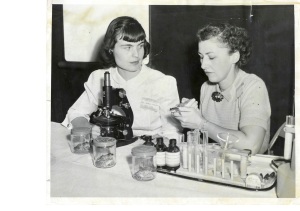The Perceptions of Pregnancy blog, like the Researchers’ Network, aims to reach beyond boundaries and borders, and to facilitate an international and interdisciplinary conversation on pregnancy and its associated bodily and emotional experiences from the medieval to the modern. Today’s post from Jesse Olszynko-Gryn explores the relationship between pregnancy testing and birth defects in the 20th century.
Atkins v. Squibb
In August 1981, People magazine reported that Wyoming attorney Gerry Spence, undefeated since 1969, had won a confidential settlement from the pharmaceutical company Squibb for parents who claimed on behalf of their young, limbless son, ‘that Gestest, the company’s now banned drug to test pregnancies, had caused grotesque birth defects.’[1]
Spence later reflected on his ‘hard decision’ to allow Squibb, as part of the settlement, to ‘seal the depositions and the testimony, by court order’ even though ‘thousands of children’ might have been affected. ‘German scientists’ had audited the trial in preparation ‘to defend similar cases in their own homeland, perhaps for the same drug company.’[2]
Though not the only litigation to bring a pregnancy test drug to court, Atkins v. Squibb, as the case was called, is the only one to result in a payout ‘rumored to be in the high seven figures’.[3] Given the secrecy and with the original court records long destroyed, we may never know what really happened. But with a UK government inquiry now underway ‘to investigate and assess evidence on children born with serious deformities due to hormone pregnancy test drugs taken by expectant mothers between 1953 and 1975’,[4] it is incumbent upon us to find out as much as possible about Gestest.
I have blogged elsewhere about Schering’s Primodos, the controversial drug at the heart of the UK inquiry, in relation to the laboratory tests that were the standard medical method of ascertaining pregnancy at the time.[5] In this post, the first of two, I investigate the origins of Primodos in West Germany, where it was called Duogynon, as well as the little-known licencing agreement between Schering and Squibb that brought Gestest, a related product, to market in the early 1960s. But first, what was Gestest.

Squibb’s Gestest
Approved by the US Food and Drug Administration (FDA) on 1 September 1961, Gestest comprised of four white tablets bearing the Squibb imprint (three columns) to be taken twice daily for two days. As with all pregnancy test drugs, it was expected to induce uterine bleeding in non-pregnant women only (a ‘negative’ result). Conversely, the absence of bleeding meant pregnancy, a ‘positive’ result. A Squibb catalogue from 1962 assured clinicians that the new drug had ‘no adverse effect on the course of an established pregnancy and may even be beneficial; the value of combined estrogen-progesterone therapy in habitual abortion is well known.’
As with many of today’s birth control pills, each tablet of Gestest contained synthetic versions of the two ovarian hormones: progesterone and estrogen. In Gestest, these were norethisterone acetate (2.5 mg) and ethinyl estradiol (0.05 mg). The latter, developed by Schering biochemists in Berlin in the late 1930s, was the first orally-active estrogen and is still the most used estrogen in oral contraceptives today.[6] The former is also a patented Schering product.
As historian Jean-Paul Gaudillière and others have shown, Schering initially marketed synthetic hormones in various dosages, regimens and combinations for a variety of conditions, including menopause, menstrual irregularities and female infertility.[7] The leading German company, today owned by Bayer, had recently rebuilt following World War II and was beginning to expand its hormone research and production lines when it launched the first, injectable version of Duogynon in the early 1950s.[8]
From Duogynon to Gestest
Duogynon initially comprised of two ampoules containing an oily, injectable mixture of norethisterone and estradiol benzoate. It was innovatively marketed as a new treatment for ‘secondary amenorrhoea’ (prolonged absence of the menses) that also doubled as a pregnancy test. Pregnancy testing quickly became the dominant indication, especially when the less expensive and more convenient Duogynon ‘oral’ became available in tablet-from in the late 1950s.
Duogynon was marketed around the world by various companies connected to Schering and under various trade names. In Britain, Pharmethicals, Schering’s UK subsidiary, called it Primodos; in France, the Paris-based Cruet (then largely owned by Schering) sold it as Proluton-oestradiol. The process whereby a modified version of Duogynon (oral) was marketed in the US by Squibb as Gestest is intricate and I am still researching it. But it all started with an agreement, the first of many, signed on 5 December 1952 between Schering and Squibb.
Schering, as an enemy company, had been cut off from the lucrative US market during the war. To regain access, Schering cut a deal whereby all its hormones, including the components of Duogynon, would be licensed to Squibb for US production and sales.
In those days, if an American company marketed another firm’s product under an American trade-name, it did not indicate this fact in the marketing literature. So it is unsurprising that the paper trail seldom explicitly links Gestest to Duogynon. Nevertheless, a letter in Schering’s corporate archives, open to historians since the 1990s,[9] confirms that Squibb ‘decided to market Duogynon oral’ in 1960-61,[10] and Gestest appears in an official list of products licensed by Schering in 1969.[11] The most plausible explanation is that Squibb tweaked Duogynon and then marketed it in the US as Gestest.
 Jesse Olszynko-Gryn is a Wellcome Trust Research Fellow in the Department of History and Philosophy of Science and Director of Studies at St John’s College, University of Cambridge. He is currently writing a book on the history of pregnancy testing in Britain, from around 1900 to the present.
Jesse Olszynko-Gryn is a Wellcome Trust Research Fellow in the Department of History and Philosophy of Science and Director of Studies at St John’s College, University of Cambridge. He is currently writing a book on the history of pregnancy testing in Britain, from around 1900 to the present.
Acknowledgements: This research was supported by the Wellcome Trust (106553) and would not have been possible without help from Thore Grimm (Schering Archive, Schering History), Gregory Higby (American Institute of the History of Pharmacy), Cyrille Jean (Sciences Po), Liz Lane (Sky News), Marie Lyon (Association for Children Damaged by Hormone Pregnancy Tests), and John P. Swann (FDA History Office).
______________________
Image 1: A elegant advertisement for Primodos (c.1957), created by Schering’s in-house team of graphic designers, then headed by Gerhard Marx. With kind permission of Schering Archives, Schering History, Berlin.
Image 2: In the 1950s, when pregnancy test drugs were first developed, a doctor would typically post a patient’s urine specimen to a laboratory, where a technician would inject the urine into a test animal, such as a female rabbit or male frog. The presence of human pregnancy hormone, today known as hCG, would provoke a physiological reaction in the animal, which counted as a ‘positive’ result. In the case of the ‘male frog test’, pictured here, the test animal would produce sperm, which was readily visible under the microscope, also pictured. No reaction meant no pregnancy, a ‘negative’ result. These tests were highly reliable, but expensive to perform and usually contingent on access to a laboratory with animals. Press photograph of the ‘male frog test’ for pregnancy, taken by Paul Olsen in Chicago, on 16 December 1952. Medical technician ‘Mrs. Donald Simerson’ looks on while Minnesota gynaecologist, Dr Jane Hodgson, performs the injection. With kind permission of Sun-Times Media.
[1] Cheryl McCall, ‘For country lawyer Gerry Spence, it’s open Season on big corporations’, People, 24 August 1981, http://people.com/archive/for-country-lawyer-gerry-spence-its-open-season-on-big-corporations-vol-16-no-8/.
[2] Gerry Spence and Anthony Polk, Gunning for Justice: My Life and Trials (New York: Doubleday, 1982), pp.79 and 82, http://www.gerryspence.com/out-of-print/gunning-for-justice/.
[3] Cheryl McCall, ‘For country lawyer Gerry Spence, it’s open Season on big corporations’, People, 24 August 1981, http://people.com/archive/for-country-lawyer-gerry-spence-its-open-season-on-big-corporations-vol-16-no-8/.
[4] ‘Inquiry into the into hormone pregnancy tests: Debate pack’ (Number CPD 2016/0171), 11 October 2016, http://researchbriefings.parliament.uk/ResearchBriefing/Summary/CDP-2016-0171.
[5] Jesse Olszynko-Gryn, ‘Primodos was a revolutionary oral pregnancy test. But was it safe?’ The H-Word, 13 October 2016, ; Jesse Olszynko-Gryn, ‘The contentious history of pregnancy test drugs: Will science find its own path to the truth?’ History & Policy, 18 October 2016, http://www.historyandpolicy.org/opinion-articles/articles/the-contentious-history-of-pregnancy-test-drugs.
[6] Wolfgang Frobenius, A Triumph of Scientific Research: The development of ethinylestradiol and ethinyltestosterone: a story of challenges overcome (Casterton Hall: Parthenon, 1990).
[7] For example, Jean-Paul Gaudillière, ‘Better prepared than synthesized: Adolf Butenandt, Schering Ag and the transformation of sex steroids into drugs (1930-1946)’, Studies in History and Philosophy of Biological and Biomedical Sciences, 36 (2005), pp. 612-644,
[8] For some background: Schering Corp. v. Schering Aktiengesellschaft, 667 F. Supp. 175 (D.N.J. 1987),
[9] Christopher Kobrak and Andrea H. Schneider, ‘Big business and the Third Reich: An Appraisal of the Historical Arguments’, in Dan Stone (ed.), The Historiography of the Holocaust (Houndmills: Palgrave Macmillan, 2004), pp. 141-172, on p.165,
[10] Schering AG to Mr. Fred Stock, E.R. Squibb & Sons, New York, 10 October 1960, Schering Archives, Berlin (B8 131).
[11] Products list, 1969, p. 2, Schering Archives, Berlin (S1 166).
